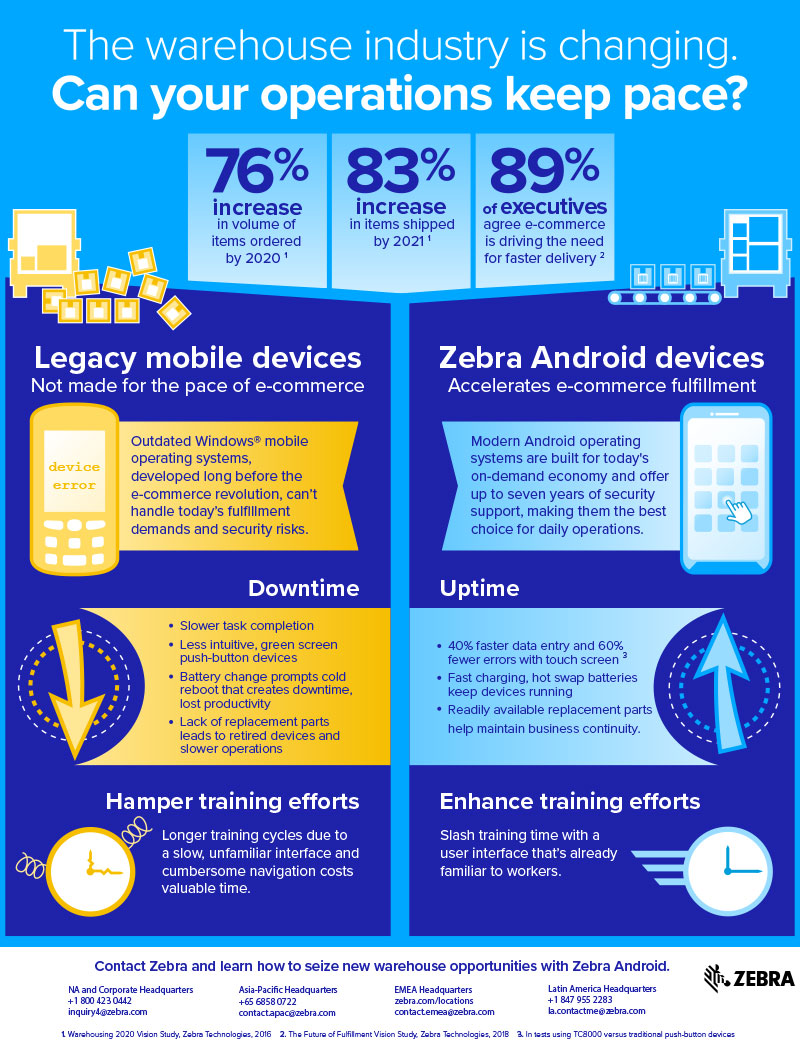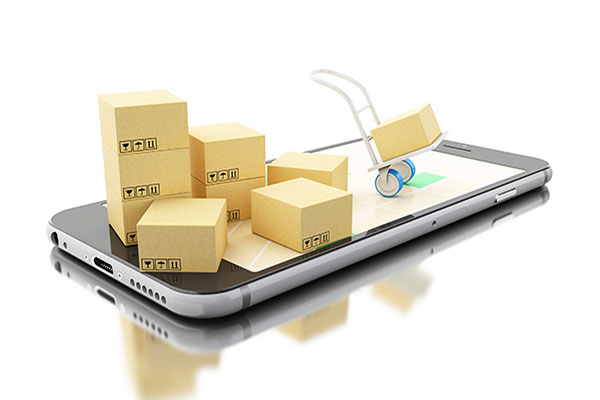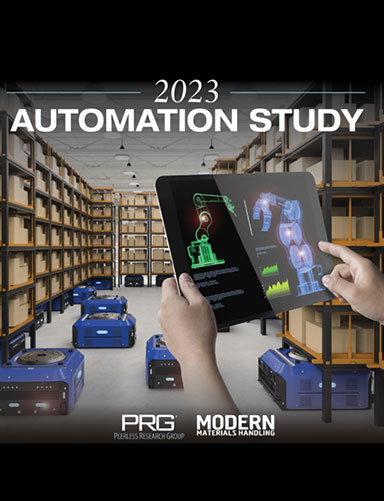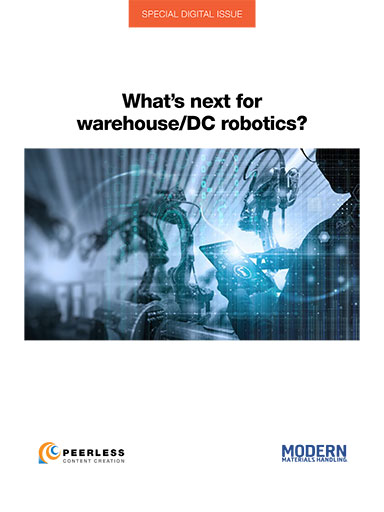Increased Ecommerce Sales Require a Modern Mobile Solution

As more information is captured at more points throughout the DC and supply chain, users and providers of scanning technology are reimagining how best to make sense of a data-dense world.
The Rise of Android
Since the early 2000s, the majority of handhelds used in Distribution Centers and carried by delivery drivers were using the Microsoft Windows CE operating system (OS).
Following the 2015 announcement that support for CE would sunset, users were also told that those devices running a legacy Windows mobile OS cannot be upgraded to Microsoft’s new mobile version, called Windows 10 IoT Enterprise.
At a crossroads requiring a massive overhaul, many users have opted for Android, an OS born of consumer tech that is making substantial inroads in enterprise applications.
Mark Wheeler, director of supply chain solutions for Zebra Technologies, says the Android migration is a significant factor for many players, even large and established ones with plenty of IT resources.
Mark Wheeler;
“There is now acceptance that Android is the future of computing at the edge. With that comes a shift from IT-management-oriented hardware decisions to more operations-oriented objectives. We see a lot of excitement and investment around solutions that are easier to learn and use.”
Bryan Boatner, director of product marketing for Cognex, agrees, especially with the imminent approach of peak season that will require rapid onboarding for temporary staff. Using “sleds” that grant scanning capabilities and ruggedness to the latest consumer devices, managers can deploy familiar technology while leveraging tools to manage those devices and achieve visibility into hardware that runs different versions of firmware or operating systems.
Bryan Boatner;
“As you look at needs of consumers and warehouses, many are similar. Better speed, better and richer and more intuitive interfaces, IP-68 and ruggedness. A lot of those goals are common.”
Boatner adds that the adoption of user-friendly consumer products, whether Android or Apple’s iOS, has helped streamline customers’ OS strategies. He describes an OS-agnostic terminal platform that can help unify, for example, the Android devices companies use in their warehouses with the iOS devices they use in the field.
Sleds can leverage the latest processing speed, security, cameras and screen resolutions of consumer devices to improve the worker experience. But, importantly, they don’t need to tinker with the foundational software that drives processes.
For example, Boatner says the market leaders for terminal emulation are adopting a strategy of enabling the automatic conversion from the green screen to a more modern, app-based, touchscreen interface.

Bryan Boatner:
“Customers are risk-averse, and as unsexy an interface as the green screen is, warehouse workers can trust it, and it’s reliable. That’s because of the way it integrates into the ‘back end.’ But that doesn’t change when the interface changes. You get the best of both worlds: a robust back-end connection and all the benefits of an easier-to-use interface.”
Intuitive interfaces that dramatically speed up onboarding have a lot of value, especially given the current labor shortages, Wheeler says. In addition to learning quickly, new Android-based tools help workers get the job done even faster. Wheeler describes a utility that can use either a scanner or camera to capture multiple barcodes at once - up to 100 at a time. A pallet at receiving with 50 unique cases might now require one trigger pull instead of a cramp-inducing 50.
Wheeler highlights another solution that uses optical character recognition, 3D capture, and scanning technology to support the physical process of loading a trailer. Together, the captured data give systems unprecedented insight.
In the past, the only interface between the physical world and the enterprise resource planning (ERP) or warehouse management system (WMS) of record has been through someone keying in data, scanning it, or maybe a materials handling system that scans, Wheeler, explains. “We’re now moving toward technologies that sense the physical world directly and use analytics to make useful information out of data. It’s a real fundamental change,” he says.
They say you can’t manage what you don’t measure, but that doesn’t stop people from trying. For example, without the smart trailer scanning system described above, the management team’s information about outbound transportation use is probably anecdotal and intuitive, Wheeler, says, instead of being based on hard data.
Mark Wheeler;
“As a result, managers might invest in different size trailers, or specialized decking to double stack, or entertain any number of other solutions, but without hard data it’s kind of guesswork. With better visibility into what’s actually happening, management teams can identify the right investments in the long term. In the short term, they can react in real time to issues without roaming the docks and just hoping to spot an issue.”
Scanning on the go
The growing popularity of wearables takes mobility and ease of use to the next level. Whether case picking, sortation or outbound load verification anywhere along the chain where it’s critical to verify the right item in the right quantity and even the exact serial numbers - Wheeler says it’s important for the ergonomics to be optimal so the technology does not interfere with the work.
“Advances in the capability of handhelds and wearables are really key as we see the need to capture more data at more points in the supply chain, which has to be done productively,” Wheeler says.
Bruce Stubbs, director of supply chain marketing at Honeywell Safety and Productivity Solutions adds that wearables also increase the attractiveness of the work and retention of those performing it.
“If you’re not using the latest and greatest, not only will you be less profitable, you will have a hard time capturing and retaining employees. The workforce is much more tech-savvy than ever before, and when they enter the workforce they want to be empowered.”
For older generations of people and technology, change management was more difficult. It was harder to learn and there was often pushback. This generation expects it, Stubbs says.
“If you are operating in a way that does not provide that kind of work satisfaction it can erode morale,” says Stubbs, noting a WERC study that found 43% of DC executives have trouble with turnover, and the biggest reason was low morale.
Bruce Stubbs;
“A company that embraces these technologies can reward employees for going above and beyond. The paper environment is very subjective, and not in real time. Technology makes the work more interesting.”
That said, a DC operation has four critical aspects: Facility, people, processes and technology. All four must work in concert, but Stubbs argues processes could be the most critical.
“All the ways we use technology to capture, interpret and pass data, and all the back-end systems, are not going to help drive better business and efficiencies if married to bad processes,” Stubbs says.
“If you use the greatest technology without best practices on the floor, all you’re doing is creating an expensive bad process.”
Related Resources
Modernizing the Warehouse with Zebra’s Android
New market dynamics require greater fulfillment speed, and your legacy mobile devices can’t meet the need like Zebra Android devices can. Download Now!
Building the Smarter Warehouse: Warehousing 2020
This online survey asked IT and operations personnel in the manufacturing, retail, transportation, and wholesale market segments to share their insights and business plans over the next five years, in light of a rapidly changing industry. Download Now!
Future of Fulfillment Vision Study
Zebra Technologies commissioned a global research study to gain a richer understanding of how manufacturers, retailers, and logistics firms are preparing to meet the growing needs of the on-demand economy, the surveys were designed to reveal plans, implementation levels, experiences and attitudes toward omnichannel logistics. Download Now!
More Resources from Zebra Technologies
Article Topics
Zebra Technologies News & Resources
Data Capture: Bar coding’s new companions Zebra Technologies introduces wearable computers Data Capture: Bar coding’s new friends Retail distribution closes in on the customer Enhance Your 3PL Operations in 2024 with the Latest Technology Solutions Automatic data capture (ADC): Accelerating the process Van Meter: Saving space while increasing throughput More Zebra TechnologiesLatest in Technology
Spotlight Startup: Cart.com is Reimagining Logistics Walmart and Swisslog Expand Partnership with New Texas Facility Taking Stock of Today’s Robotics Market and What the Future Holds Biden Gives Samsung $6.4 Billion For Texas Semiconductor Plants Apple Overtaken as World’s Largest Phone Seller Walmart Unleashes Autonomous Lift Trucks at Four High-Tech DCs Talking Supply Chain: Procurement and the AI revolution More TechnologyAbout the Author

















